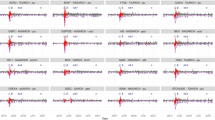Abstract
Following the 1987 stock market crash, trading controls or circuit breakers were implemented in financial markets to moderate extreme volatility. However, the effectiveness of circuit breakers on the operation of these markets is disputed. While some argue that circuit breakers curb the effects of overreaction in markets and restore confidence, others argue that these trading interruptions merely delay price movements to later periods or to other markets. This paper examines the effect of changes in circuit breaker rules on the market's expectation of future volatility. The results have policy implications and suggest that the circuit breaker rule changes have no effect on expected volatility.
Similar content being viewed by others
References
Bessembinder, Hendrick; Seguin, Paul J. "Price Volatility, Trading Volume, and Market Depth: Evidence from Future Markets,"Journal of Financial and Quantitative Analysis, 28, 1, March 1993, pp. 21–39.
Black, Fischer; Scholes, Myron S. "The Pricing of Options and Corporate Liabilities,"Journal of Political Economy, 81, 3, May–June 1973, pp. 637–54.
Box, G. E. P.; Tiao, G. C. "Intervention Analysis with Applications to Economic and Environmental Problems,"Journal of the American Statistical Association, 70, 349, March 1975, pp. 70–9.
Dickey, David A.; Fuller, Wayne A. "Likelihood Ratio Statistics for Autoregressive Time Series with a Unit Root,"Econometrica, 49, 4, June 1981, pp. 1057–72.
__. "Distributions of the Estimators for Autoregressive Time Series with a Unit Root,"Journal of the American Statistical Society, 74, 366, June 1979, pp. 427–31.
Gerety, Mason S.; Mulherin, J. Harold. "Trading Halts and Market Activity: An Analysis of Volume at the Open and the Close,"Journal of Finance, 47, 5, December 1992, pp. 1765–84.
Greenwald, Bruce C.; Stein, Jeremy C. "Transactional Risk, Market Crashes, and the Role of Circuit Breakers,"Journal of Business, 64, 4, October 1991, pp. 443–62.
Karpoff, Jonathan M. "The Relation between Price Changes and Trading Volume: A Survey,"Journal of Financial and Quantitative Analysis, 22, 1, March 1987, pp. 109–26.
Kuhn, Betsey A.; Kuserk, Gregory J.; Locke, Peter. "Do Circuit Breakers Moderate Volatility? Evidence from October 1989," working paper, Washington, DC: United States Department of Agriculture, 1990.
Lamoureux, Christopher G.; Lastrapes, William D. "Heteroskedasticity in Stock Return Data: Volume versus GARCH Effects,"Journal of Finance, 45, 1, March 1990, pp. 221–9.
Lauterbach, Beni; Ben-Zion, Uri. "Stock Market Crashes and the Performance of Circuit Breakers: Empirical Evidence,"Journal of Finance, 48, 5, December 1993, pp. 1909–25.
Ma, Christopher K.; Rao, Ramesh P.; Sears, R. Stephen. "Limit Moves and Price Resolution: The Case of the Treasury Bond Futures Market,"Journal of Futures Markets, 9, 4, August 1989a, pp. 321–35.
__. "Volatility, Price Resolution, and the Effectiveness of Price Limits,"Journal of Financial Services Research, 3, 2–3, December 1989b, pp.165–99.
MacKinnon, J. G. "Critical Values for Cointegration Tests," working paper, San Diego, CA: University of California, San Diego, 1990.
McMillan, Henry. "Circuit Breakers in the S&P 500 Futures Market: Their Effect on Volatility and Price Discovery in October 1989," working paper, Washington, DC: Office of Economic Analysis, U.S. Securities and Exchange Commission, 1990.
Mills, Terence C.The Econometric Modelling of Financial Time Series, New York, NY: Cambridge University Press, 1993.
Pantula, Sastry G.; Gonzalez-Farias, Graciela; Fuller, Wayne A. "A Comparison of Unit-Root Test Criteria,"Journal of Business and Economic Statistics, 12, 4, October 1994, pp. 449–59.
Presidential Task Force on Market Mechanisms.Report of the Presidential Task Force on Market Mechanisms, Washington, DC: U. S. Government Printing Office, January 1988.
Santoni, G. J.; Liu, Tung. "Circuit Breakers and Stock Market Volatility,"Journal of Futures Markets, 13, 3, May 1993, pp. 261–77.
Subrahmanyam, Avanidhar. "Circuit Breakers and Market Volatility: A Theoretical Perspective,"Journal of Finance, 49, 1, March 1994, pp. 237–54.
Tsay, Ruey S. "Outliers, Level Shifts, and Variance Changes in Time Series,"Journal of Forecasting, 7, 1988, pp. 1–20.
Author information
Authors and Affiliations
Rights and permissions
About this article
Cite this article
Ackert, L.F., Hao, J. & Hunter, W.C. The effect of circuit breakers on expected volatility: Tests using implied volatilities. Atlantic Economic Journal 25, 117–127 (1997). https://doi.org/10.1007/BF02298379
Issue Date:
DOI: https://doi.org/10.1007/BF02298379




